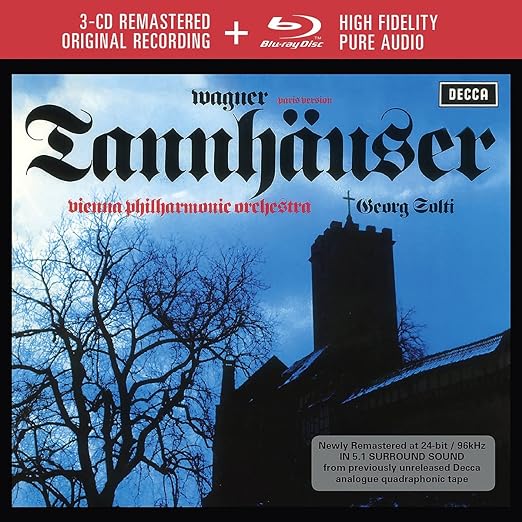McCrutchy
Well-known Member

Decca will release a Blu-ray Audio / CD edition of Sir Georg Solti's recording of Wagner's Tannhäuser (1971), apparently with a new 5.1 mix made from the Quadraphonic tapes.
You can purchase it here at Amazon.com:
https://www.amazon.com/dp/B07C5K7SP7
Or internationally, by using the same ASIN product number, for example:
https://www.amazon.ca/dp/B07C5K7SP7
https://www.amazon.co.uk/dp/B07C5K7SP7
https://www.amazon.fr/dp/B07C5K7SP7
https://www.amazon.de/dp/B07C5K7SP7
https://www.amazon.it/dp/B07C5K7SP7
Here is the product description in the Amazon listing:
Deluxe Hardback Edition with CD + libretti + Blu-ray Audio!
Who knew that Decca experimented with quadrophonic recording? No “quad” recording ever bore the traditional Decca FFSS trademark and Decca’s forays into quadrophonic recording have never-before been released – until now.
Getting the sound right at the recording session has always been a hallmark of the Decca Sound. While Decca’s Phase 4 label had been making multi-channel recordings since 1964, new ‘quadraphonic’ recording techniques developed in the late 1960s allowed engineers to capture a greater spatial ambience. In the autumn of 1969, quietly and behind the scenes, Decca began to experiment with quadraphonic sound, first in its Hampstead studios, and the next spring in the Sofiensaal recording the Vienna Philharmonic, where the new miking techniques were employed to create a sense of movement in the different arrivals and departures of the Pilgrims.
Decca was to make the sound marketing decision not to issue any “quad” recordings – quadraphonic releases were a commercial failure due to the high production costs and the costs of the playback equipment, coupled with the technical limitations of cutting the extremely high frequencies into vinyl as well as tracking these without distortion. Recording operas in the Decca style, and especially in stereo, presented. Today, Blu-ray Audio allows us to hear for the first-time producer Ray Minshull’s original vision and re-present in “Surround Sound” Decca’s accomplishments through the High Fidelity Pure Audio 5.1 surround mix in this reissue.
Georg Solti’s readings of Wagner’s great operas are among the most thrilling experiences on record. The evenness and strength of the cast is balanced with the brilliance of the Wiener Philharmoniker and recorded with the renowned Decca clarity and richness.
• Tannhauser Presented in 5.1 Surround Sound on one Blu-ray Audio disc and mastered at 24-bit/96kHz from the never-before released 1970 experimental quadraphonic tapes
• 3CDs + High Fidelity Pure Audio Blu-ray disc containing the complete opera in 24-bit audio Deluxe hard-back edition with original cover
• Includes libretto, and synopsis both with English, German and French translations
• Mastering from original analogue sources by former Decca engineer, Paschal Byrne.
TANNHAUSER – THE PARIS EDITION
Though popularity for Wagner’s Tannhauser in its original Dresden (1845) version spread rapidly, Wagner frequently felt drawn to make minor alterations to the score. An Imperial command to produce it in Paris in 1861 prompted the more substantial revisions which distinguish the Paris version from the Dresden and despite the fact that the first three performances in Paris were such an unmitigated disaster that Wagner withdrew both the opera and himself, he clearly felt that the new version was preferable to the old, once it had been restored to German. From the outset of Decca’s recording project with Solti there was no doubt that this would be the version used, though under the umbrella-title of “Paris version” several choices still have to be made. It was felt quite simply that Tannhäuser becomes an even greater work by virtue of the revisions.



